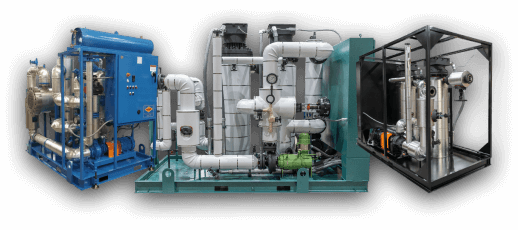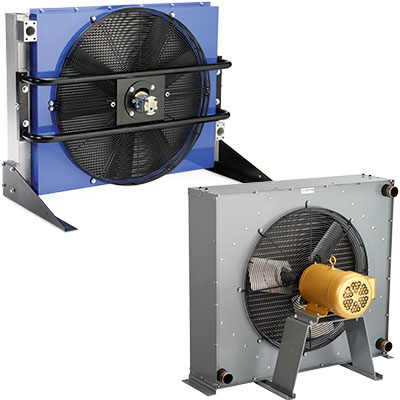How DVS Heat Transfer Systems Support Lifecycle Sustainability from Design to Disposal
A Comprehensive Guide to Picking the Right Heat Transfer Equipments for Your Requirements
Picking the suitable Heat transfer system is important for functional performance. Numerous systems accommodate different requirements, influenced by variables such as temperature range and liquid kind. Recognizing the concepts behind Heat transfer, such as convection, radiation, and conduction, is critical. Additionally, examining power resources and maintenance practices can impact long-term efficiency. A closer evaluation of these considerations reveals exactly how to customize a system to specific needs. What should one prioritize in this facility decision-making procedure?
Understanding Heat Transfer: Secret Principles and Principles
Heat transfer may appear like a straightforward principle, it includes a range of concepts that are essential for reliable system layout - DVS Heat Transfer Systems. Understanding these principles is crucial for designers and designers that intend to maximize thermal performance in various applications. Transmission, as an example, includes the transfer of Heat through solid products, while convection describes the motion of Heat within fluids. Radiation, one more vital concept, describes exactly how Heat can be moved via electro-magnetic waves. Each of these devices plays a vital duty in identifying just how energy moves within a system. By completely realizing these concepts, specialists can make enlightened decisions, making certain that Heat transfer systems run efficiently and fulfill the particular needs of their applications
Sorts Of Heat Transfer Systems: A Summary
Comprehending the concepts of Heat transfer lays the groundwork for discovering the various types of Heat transfer systems offered. Heat transfer systems can be categorized mostly right into 3 kinds: conduction, radiation, and convection. Transmission entails Heat transfer with solid products, relying upon direct get in touch with between bits. Convection, on the other hand, takes place in fluids (gases and liquids) where the activity of the fluid itself helps with Heat transfer. Radiation includes the transfer of Heat via electro-magnetic waves and does not need a medium, enabling it to take place in a vacuum. Each sort of system has distinctive characteristics and applications, making it vital for people and companies to thoroughly assess their specific requirements when picking one of the most ideal Heat transfer option.
Applications of Heat Transfer Systems in Various Industries
Heat transfer systems play a crucial role across numerous markets, affecting performance and product top quality. In industrial manufacturing procedures, they assist in specific temperature level control, while in food and drink processing, they assure safety and security and conservation. Furthermore, cooling and heating and environment control systems rely heavily on efficient Heat transfer to maintain comfortable environments.
Industrial Manufacturing Processes

Many industrial production processes depend heavily on effective Heat transfer systems to make best use of efficiency and boost item quality. In industries such as metalworking, Heat exchangers play a vital function in keeping suitable temperature levels throughout welding, spreading, and creating. These systems assure uniform Heat distribution, which is important for attaining preferred material properties. In a similar way, in the chemical manufacturing sector, Heat transfer systems facilitate precise temperature level control throughout reactions, influencing yield and safety and security. Moreover, in fabric production, efficient Heat administration is crucial for dyeing and completing processes, influencing shade uniformity and fabric high quality. By selecting ideal Heat transfer technologies, producers can enhance energy efficiency and reduce operational expenses, eventually bring about a more sustainable and affordable production atmosphere.
Food and Beverage Handling
Effective Heat transfer systems are similarly crucial in the food and beverage processing market, where keeping perfect temperatures is important for food security and quality. These systems play a vital role in processes such as sterilization, cooking, and pasteurization, guaranteeing that products are safe for intake and preserve their dietary value. Heat exchangers, for instance, successfully transfer Heat in between liquids, enhancing power use while minimizing temperature fluctuations. In addition, refrigeration systems are basic for extending and preserving disposable items life span. The option of Heat transfer modern technology directly impacts operational effectiveness and product honesty, making it necessary for food and beverage producers to pick the ideal systems customized to their details processing needs. This careful selection inevitably contributes to customer satisfaction and food security.

HVAC and Climate Control
While several markets count on Heat transfer systems for effectiveness, COOLING AND HEATING (Home Heating, Ventilation, and A/c) plays an important function in keeping indoor environment control throughout various settings. These systems use Heat transfer concepts to control humidity, temperature, and air top quality, making certain convenience and security in residential, commercial, and industrial atmospheres. Appropriately designed HVAC systems enhance power effectiveness, lower functional costs, and lessen environmental impact. In industrial buildings, for instance, reliable climate control contributes to employee productivity and customer complete satisfaction. In industrial applications, heating and cooling systems assist preserve excellent problems for equipment procedure and product conservation. Selecting the right Heat transfer system is essential for meeting particular climate control needs and attaining overall system efficiency.
Evaluating Energy Resources for Heat Transfer Equipments
In assessing power sources for Heat transfer systems, a contrast of renewable resource choices and nonrenewable fuel source considerations is vital. Eco-friendly sources, such as solar and wind, offer lasting options that can reduce ecological influence. On the other hand, fossil fuels remain widespread due to their established facilities and power thickness, prompting a mindful assessment of both alternatives.
Renewable Resource Options

Fossil Fuel Considerations
Assessing fossil fuel factors to consider is crucial for the performance and sustainability of Heat transfer systems. Fossil fuels, such as natural gas, oil, and coal, are typical power resources that offer significant Heat outcome, making them popular selections for commercial and household applications. Their environmental effect, including greenhouse gas discharges and source depletion, increases worries. When picking a heat transfer system, it is crucial to examine the availability, price, and regulative aspects connected with these fuels. Additionally, the effectiveness of fossil fuel systems need to be taken into consideration, as higher efficiency can mitigate some ecological disadvantages. Inevitably, a balanced strategy evaluating performance check out this site and sustainability can direct decision-makers towards the most proper Heat transfer remedy for their specific demands.
Aspects to Consider When Choosing a Warm Transfer System
Choosing an ideal Heat transfer system requires cautious consideration of different variables that can substantially influence performance and efficiency. One crucial element is the operating temperature variety, which dictates the materials and design ideal for the application. In addition, the kind of fluid used in the system-- whether gas or liquid-- impacts Heat transfer efficiency and compatibility. The system's size and capacity have to straighten with the specific demands of the procedure to avoid inefficiencies. Power resource availability is also vital, affecting operating costs and sustainability. Moreover, the installment atmosphere, consisting of room restrictions and availability for upkeep, plays a considerable duty in system option. Regulatory compliance and safety and security criteria should be taken into consideration to assure the system satisfies all legal requirements.
Upkeep and Efficiency Optimization for Heat Transfer Systems
Maintaining Heat transfer systems is essential for making sure maximum effectiveness and durability. Regular maintenance tasks, such as cleansing Heat exchangers and evaluating insulation, aid protect against efficiency losses as a result of fouling and thermal linking. Furthermore, monitoring system specifications, consisting of stress and temperature, permits early discovery of anomalies, minimizing downtime and pricey repair work. Executing a preventive maintenance schedule can maximize efficiency and extend the life-span of elements. Upgrading to innovative control systems can boost discover here functional efficiency by adjusting to varying tons and problems. By focusing on upkeep and effectiveness optimization, drivers can attain decreased power consumption, reduced functional costs, and boosted overall system reliability, eventually resulting in far better resource utilization and a much more sustainable procedure.
Future Trends in Heat Transfer Technologies
As markets progressively focus on sustainability and power efficiency, future fads in Heat transfer innovations are readied to undertake considerable makeovers. Innovations such as innovative products, consisting of carbon nanotubes and nanofluids, assure improved thermal conductivity and efficiency. In addition, the assimilation of eco-friendly power sources into Heat transfer systems is obtaining energy, promoting environment-friendly solutions. Smart innovations, including IoT sensing units, are expected to reinvent tracking and control, making it possible for real-time data evaluation for optimized performance. Furthermore, the growth of portable and modular systems will help with less complicated setup and upkeep, dealing with diverse applications. These developments show a change towards even more lasting, efficient, and adaptable Heat transfer remedies, lining up with international power objectives and environmental standards.
Often Asked Questions
What Are the Environmental Effects of Heat Transfer Systems?
The environmental impacts of Heat transfer systems can consist of greenhouse gas exhausts, power consumption, and possible thermal pollution. Furthermore, incorrect disposal of inefficiencies and products can add to resource deficiency and ecological community interruption.
How Do I Compute the Cost-Effectiveness of a Warm Transfer System?
To calculate the cost-effectiveness of a warmth transfer system, one must analyze first expenses, operational expenditures, maintenance needs, and power performance, comparing these elements against the anticipated life-span and performance of the system.
Can Heat Transfer Equipment Be Made Use Of in Residential Setups?
Heat transfer systems can undoubtedly be made use of in household settings. They supply reliable heating and cooling down remedies, making homes a lot more comfy while possibly decreasing power costs. Their versatility permits various applications in household settings.
What Safety And Security Rules Put On Heat Transfer Systems?
Safety regulations for Heat transfer systems normally consist of guidelines on upkeep, installment, and operation. Compliance with neighborhood building codes, manufacturer specs, and market criteria is vital to assure efficient and risk-free system efficiency in numerous applications.
Just How Do Various Materials Affect Heat Transfer Effectiveness?

Transmission, for circumstances, involves the transfer of Heat with strong products, while convection refers to the movement of Heat within liquids. Understanding the concepts of Heat transfer lays the groundwork for exploring the various types of Heat transfer systems offered. Heat pop over to these guys exchangers, for instance, efficiently transfer Heat in between fluids, enhancing power usage while decreasing temperature variations. In evaluating power resources for Heat transfer systems, a contrast of sustainable power choices and fossil gas considerations is vital. Steels, such as copper and light weight aluminum, conduct Heat efficiently, whereas insulators like rubber and glass reduce down Heat circulation.